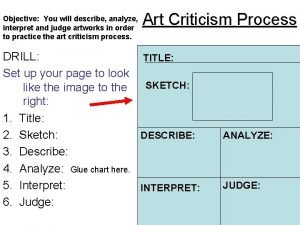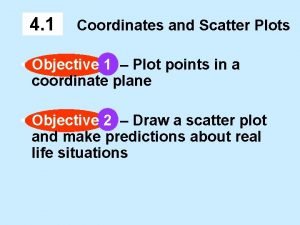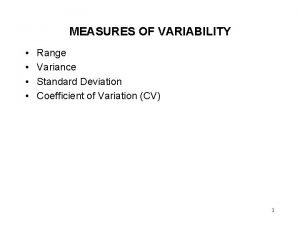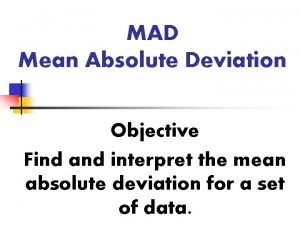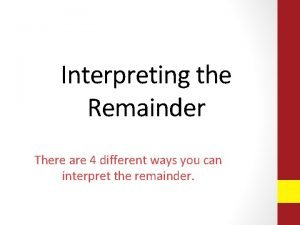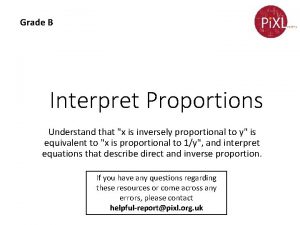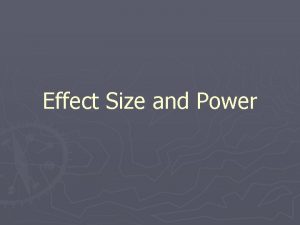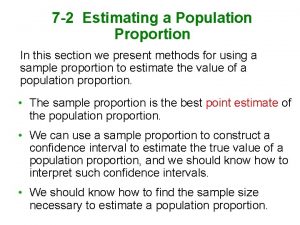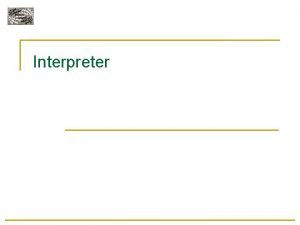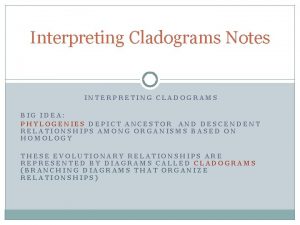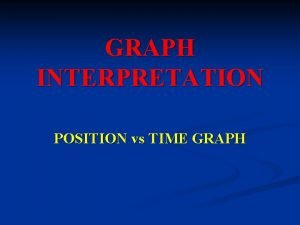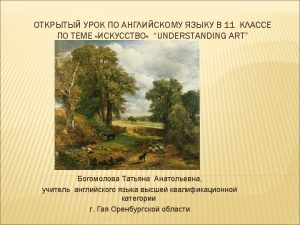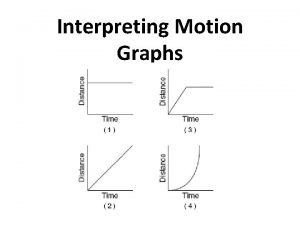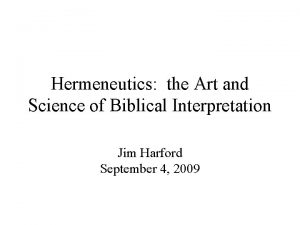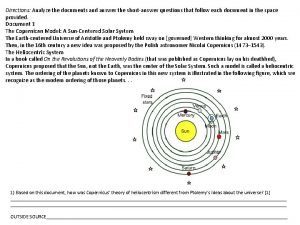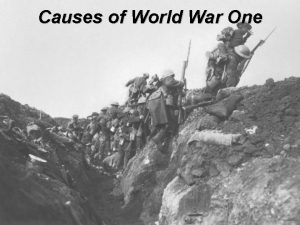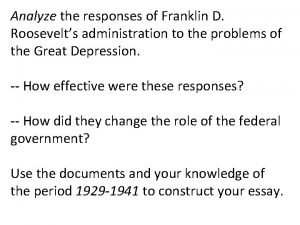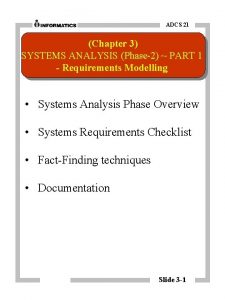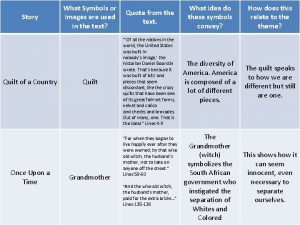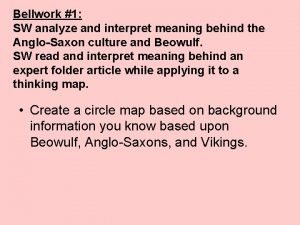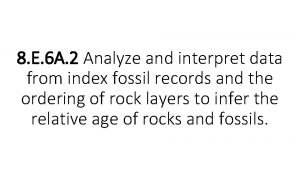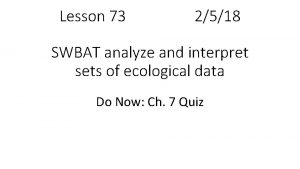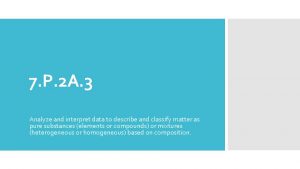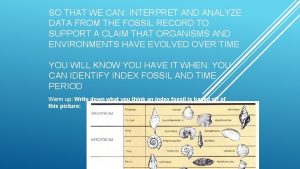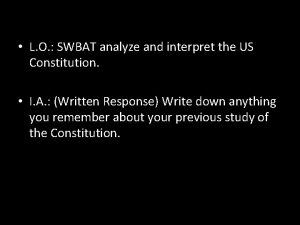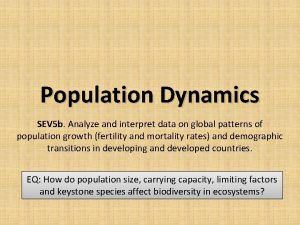8 E 6 A 2 Analyze and interpret


























































































- Slides: 90

8. E. 6 A. 2 Analyze and interpret data from index fossil records and the ordering of rock layers to infer the relative age of rocks and fossils.

Activity # 1 • On your desk, you have 8 large colored index cards with nonsense letters placed on them. • Your task is to determine what the correct sequence of the letters are. • You have two clues: 1. The card with the letters “C” and “T” is on the bottom, or the oldest layer 2. Look for a card that has either a “T” or “C” written on it for the second layer

You have two clues: The card with the letters “C” and “T” is on the bottom, or the oldest layer Look for a card that has either a “T” or “C” written on it for the second layer • Questions when you finish: 1. What letter is the oldest? 2. What letter is the youngest? 3. What letter showed up the most? 4. Which letters only showed up once? 5. Which letters could be index fossils? 6. How did you know which was older: “M” or “X”?

• This is one possible way to arrange the cards. • M D • DXO • Questions: 1. What letter is the oldest? 2. What letter is the youngest? 3. What letter showed up the most? 4. Which letters only showed up once? 5. Which letters could be index fossils? 6. How did you know which was older: “M” or “X”? • ON • N B • NB U • UA • AGC • C T

ESSENTIAL QUESTION • What is the law of superposition?

8. E. 6 A. 2 Analyze and interpret data from index fossil records and the ordering of rock layers to infer the relative age of rocks and fossils.

• The relative age means the age of one object compared to the age of another object. Relative age does not tell the exact age of an object. The relative age of rocks and fossils can be determined using two basic methods: • 1. ordering of rock layers • 2. index fossils:

Relative and Absolute Ages Relative Age The age of a rock compared to the ages of rock layers. Ex: younger vs. older ¡ Absolute Age The age of a rock given as the number of years since the rock formed. ¡ Ex: 10, 20, 50, 100 ¡

PRACTICE

PRACTICE


ORDERING OF ROCKS ¡ ¡ Scientists read the rock layers knowing that each layer is deposited on top of other layers. The law of superposition states that each rock layer is older than the one above it. So, the relative age of the rock or fossil in the rock is older if it is farther down in the rock layers. Relative dating can be used only when the rock layers have been preserved in their original sequence.

Position of Rock Layers Its difficult to determine the absolute age so geologists use methods to find a rock’s relative age. Use the: LAW OF SUPERPOSITION: in horizontal sedimentary rock layers, the oldest layer is at the bottom and the youngest layer is at the top. Each higher layer is younger than the layers below it.




l Complex layering due to intrusions and extrusions, faults, or unconformities can make dating rocks and fossils challenging.

Other Clues to Relative Age Clues from Igneous Rocks: 1. Lava that hardens on the surface is called an Extrusion (example – an eruption would put a layer of igneous rock on top of sedimentary rocks. A. Rock layers below an extrusion are always older than the extrusion.

The extrusion is in black

Now the extrusion is the youngest layer.

A. Clues from Igneous Rocks: 2. Magma that cools and pushes into bodies of rock and hardens is called an Intrusion An intrusion is always younger than the rock layers around and beneath it. It is considered a cross-cutting section.

The intrusion (in red) is now younger than the surrounding rocks.

Draw this in your notes and label each of the parts listed below. 1. Intrusion 2. Extrusion 3. Oldest rock 4. Youngest rock


B. Clues from Faults: Fault: is a break in the Earth’s crust. • Forces inside the Earth cause movement of the rock on opposite sides of a fault. • Fault is always younger than the rock it cuts through. It is considered a crosscutting section.







REVIEW n Geologists use the Relative and Absolute Age of rocks to determine age. n Using the Law of Superposition n Other clues are from Igneous rocks – Extrusion – Intrusion n Clues from Faults

Question Which is most likely to become a fossil? p p A. a skeleton in a large lake p B. a jellyfish in the ocean p C. an earthworm in a damp forest p D. a skeleton in a riverbed that is drying up p

GAPS IN THE GEOLOGIC RECORD - Record of sedimentary rock layers is not always complete - Deposition slowly builds layers upon layer of sedimentary rock, BUT some of these layers may erode away, exposing an older rock surface. Unconformity – is a gap in the geologic record. An unconformity shows where some rock layers have been lost because of erosion.


USING FOSSILS TO DATE ROCKS To date rock layers, geologists first give a relative age to a layer of rock at one location. THEN they can give the same age to matching layers of rock at other locations. Certain fossils, called Index Fossils help geologist match rock layers. INDEX FOSSILS – Fossils of widely distributed organisms that lived during only one short period.

Index Fossils • Certain fossils, called index fossils, can be used to help find the relative age of rock layers. To be an index fossil – • an organism must have lived only during a short part of Earth’s history; • many fossils of the organism must be found in rock layers; • the fossil must be found over a wide area of Earth; • the organism must be unique. • ARE EXTINCT • Found only in ONE rock layer • Only lived for a Short period of time

• TRILOBITES: A key example of an organism used as an index fossil are ___TRIOBITES___, a group of hard-shelled animals whose body had three sections, lived in shallow seas, and became extinct about 245 million years ago. Therefore, if a trilobite is found in a particular rock layer, it can be compared with trilobites from other layers to estimate the age of the layer in which it was found. • • Note: Fossils that are found in many rock layers, therefore living long periods of time, do not qualify as index fossils.


• The World's Biggest Trilobite • A team of Canadian paleontologists working along Hudson Bay in northern Manitoba has discovered the world's largest recorded complete fossil of a trilobite, a many-legged, sea-dwelling animal that lived 445 million years ago. The giant creature is more than 70 cm long (about 28 inches), 70 percent larger than the previous record holder. "This is an important and amazing find, " says Bob Elias, a professor in the department of geological sciences at the University of Manitoba. "It looks like a huge bug!"







• Radioactive element decay can also be used to tell the age of fossils and rocks. Until the middle of the last century, "older" or "younger" was the best scientists could do when assigning ages to fossils. There was no way to calculate an "absolute" age (in years) for any fossil or rock layer. But after scientists learned that the nuclear decay of radioactive elements takes place at a predictable rate, they realized that the traces of radioactive elements present in certain types of rock, such as hardened lava and tuff (formed from compacted volcanic ash), could be analyzed chemically to determine the ages, in years, of those rocks.

• Law of Superposition: Oldest sedimentary rock layers will be on the bottom, youngest on top. • Principle of Original Horizontality: When layers of sedimentary rock are first made, they are layered horizontally.

Rock Layers Can Change! • Rock layers can fold underground. Can you still figure out the order from oldest to youngest? • Intrusions of igneous rock can cut through different layers, like A. The intrusion is always younger than the layers it cuts through (even if it comes from the bottom!).

• A fault or crack could form in the middle of rock layers (B). If this happens, the fault is always younger than the layers it cuts through.

Task: Put the layers in order from oldest to youngest. • Hints: • Start at oldest first – look at the bottom layers • Igneous intrusions are younger than the layers they cut through • Fault lines are younger than the layers they cut through • If igneous and metamorphic are side by side, metamorphic was there first







• 8. E. 6 A. 4 Construct and analyze scientific arguments to support claims that different types of fossils provide evidence of (1) the diversity of life that has been present on Earth, (2) relationships between past and existing life forms, and (3) environmental changes that have occurred during Earth’s history.

FOSSIL RECORD • Fossils are mineral replacements, preserved remains, or traces of organisms that lived in the past. The collection of fossils and their placement in chronological order is known as the fossil record. It documents the existence, diversity, extinction, and change of many life forms and environmental changes throughout the history of life on Earth.

FOSSIL RECORD

GEOLOGIC TIME SCALE

• Thousands of layers of sedimentary rock not only provide evidence of the history of Earth itself but also of changes in organisms whose fossil remains have been found in those layers.



• Erosion and weathering of sedimentary rock layers can cause the destruction of fossils and result in gaps in the fossil record. • Certain environmental conditions favor certain fossil formations. Therefore, the type of fossils found in an area can explain the environmental changes that have occurred.

RAPID BURIAL • The rapid burial of organisms, which is more likely to occur in marine environments, results in a greater likelihood that the remains of marine organisms will be preserved. Flash floods and volcanic ash falls help preserve land organisms.


• Certain fossilized organisms could only live in specific environments or under particular climate conditions. • Extinction of life forms as well as how and when new life forms appeared is part of the fossil record. • Fossils can show structural similarities and differences in organisms over time revealing the vast diversity of life forms that have and continue to exist on Earth.

DIVERSITY OF LIFE/DIFFERENT LIFEFORMS

• Anatomical similarities and differences between various organisms living today and between them and organisms in the fossil record enable the understanding of the diversity of life that has been present on Earth. • Comparisons between living organisms and fossils also allow scientists to make inferences about the lines of descent.

MAKING INFERENCE

• Fossil Formation In the first step of fossil formation an animal or plant must die in or near water or near enough to fall in shortly after death. In the following example a trilobite has died of old age on the bottom of the sea. Bacteria consume the soft body parts but leave the hard exoskeleton intact.

• 2 nd Step: Sedimentation • As time passes sediments bury the exoskeleton. The faster this happens the more likely fossilization will occur. Land mud slides definitely help. River deltas are also good for quick accumulation of sediments. This further insulates our trilobite from decomposition. Now we have fossil formation in progress.

• 3 rd Step Permineralization • As the sediments continue to pile on, the lower layers become compacted by the weight of the layers on top. Over time, this pressure turns the sediments into rock. • If mineral-rich water percolates down through the sediments, the fossil formation process has an even better chance of preserving our ancient animal. Some of the minerals stick to the particles of sediment, effectively gluing them together into a solid mass. . In time the entire shell is replaced leaving rock in the exact shape of the trilobite or animal. That is fossil formation at work.

• 4 th Step: Uplift • As the continental plates move around the earth, crashing into each other, mountains are formed. Former sea floors are lifted up and become dry land. This is exactly what has happened to our trilobite in the picture below. Now fossil formation is complete but our trilobite is buried under hundreds or even thousands of feet of rock! Thanks to the movement of the plates, our trilobite or fossil will come closer to the surface and nearer to discovery by some fortunate fossil hunter. Luckily nothing

• 5 th Step: Erosion at work • Fossil formation is revealed by erosion. Wind, rain, freeze and thaw, even earthquakes will help force the trilobite out of its burial ground and out into the light. If he or she is lucky enough, the trilobite will reveal itself in time to be spotted by a rock-hunter or fossil-digger. Who knows? It could even be YOU!

TYPES OF FOSSILS • Mold fossil – forms when sediments bury an organism and the sediments change into rock; the organism decays leaving a cavity in the shape of the organism. • Cast fossil – forms when a mold is filled with sand or mud that hardens into the shape of the organism.


• Petrified fossil (permineralized fossil) – forms when minerals soak into the buried remains, replacing the remains, and changing them into rock. • Preserved fossil – forms when entire organisms or parts of organisms are prevented from decaying by being trapped in rock, ice, tar, or amber.

• PETRIIED

• PRESERV ED

• Carbonized fossil – forms when organisms or parts, like leaves, stems, flowers, fish, are pressed between layers of soft mud or clay that hardens squeezing almost all the decaying organism away leaving the carbon imprint in the rock. • Trace fossil – forms when the mud or sand hardens to stone where a footprint, trail, or burrow of an organism was left behind.








 What do you see in this picture
What do you see in this picture Describe identify interpret judge
Describe identify interpret judge Dqaf
Dqaf Example of analysis and interpretation of data
Example of analysis and interpretation of data Can you judge art objectively
Can you judge art objectively Description analysis interpretation judgement
Description analysis interpretation judgement Role of quantitative research
Role of quantitative research Interpret fractions and percentages as operators
Interpret fractions and percentages as operators Understanding your health and wellness chapter 1
Understanding your health and wellness chapter 1 4-1 construct and interpret scatter plots
4-1 construct and interpret scatter plots The ability to locate interpret and apply information
The ability to locate interpret and apply information Median absolute deviation excel
Median absolute deviation excel Quick assets
Quick assets Identify
Identify Confidence level and significance level
Confidence level and significance level Theories of prejudice sociology
Theories of prejudice sociology What is a significance test
What is a significance test How to interpret regression results
How to interpret regression results Aimsweb rate of improvement
Aimsweb rate of improvement Motion graphs definition
Motion graphs definition Standard deviation interpretation example
Standard deviation interpretation example How do you find the mean absolute deviation
How do you find the mean absolute deviation Interpret the remainder
Interpret the remainder Lower quartile example
Lower quartile example Directly proportional equation
Directly proportional equation P-value interpretation
P-value interpretation Confidence interval vs confidence level
Confidence interval vs confidence level How to find the t score for a confidence interval
How to find the t score for a confidence interval Estimating a population proportion
Estimating a population proportion 2-1 interpret scatterplots
2-1 interpret scatterplots Interpret?
Interpret? Interpret cartoon
Interpret cartoon Food chain primary and secondary consumers
Food chain primary and secondary consumers Co je to interpret
Co je to interpret How to read a cumulative frequency graph
How to read a cumulative frequency graph Of what value is the weather depiction chart to the pilot
Of what value is the weather depiction chart to the pilot Interpreting a cladogram
Interpreting a cladogram Give the interpretation of the graph below:
Give the interpretation of the graph below: Consensus model criminal justice
Consensus model criminal justice How to interpret gradient
How to interpret gradient Interpret
Interpret How to interpret art
How to interpret art Interpret the weather symbol depicted in utah
Interpret the weather symbol depicted in utah Scatter plots calculator
Scatter plots calculator Interpret
Interpret Distant time graph
Distant time graph Interpret cartoon
Interpret cartoon Expository preaching
Expository preaching How to interpret art
How to interpret art Emergencypedia
Emergencypedia Interpret
Interpret Components of mil
Components of mil Analyze the picture carefully and tell something about it
Analyze the picture carefully and tell something about it What is media information
What is media information Programs that organize analyze and graph numerical data
Programs that organize analyze and graph numerical data Analyzing and drawing conclusions
Analyzing and drawing conclusions Ritual or expressive model of communication
Ritual or expressive model of communication Identify and analyze
Identify and analyze Analyze patterns and relationships
Analyze patterns and relationships Analytical questions: winter dreams answers
Analytical questions: winter dreams answers Prose diction
Prose diction Programs that organize analyze and graph numerical data
Programs that organize analyze and graph numerical data How to analyze a movie
How to analyze a movie Epic hero define
Epic hero define Diction analysis paragraph example
Diction analysis paragraph example Job analysis vs job evaluation
Job analysis vs job evaluation Anticipation guide examples
Anticipation guide examples Analyze phase - includes
Analyze phase - includes Analysis definition in literature
Analysis definition in literature Directions: analyze
Directions: analyze What is analysis of algorithm
What is analysis of algorithm Garvillo
Garvillo Analyze the cartoon below then provide
Analyze the cartoon below then provide Psychographic audience analysis
Psychographic audience analysis Art critique sentence starters
Art critique sentence starters Identify community issues and problems
Identify community issues and problems Analyze the ways in which the vietnam war heightened social
Analyze the ways in which the vietnam war heightened social Meridel lesueur, new masses, january 1932.
Meridel lesueur, new masses, january 1932. Blood spatter analyze a case
Blood spatter analyze a case An accounting device used to analyze transaction
An accounting device used to analyze transaction Analyze phase - includes
Analyze phase - includes Persepolis chapter 17
Persepolis chapter 17 Swot perfume
Swot perfume How to analyze a play
How to analyze a play Janet waking
Janet waking Analyze customer satisfaction
Analyze customer satisfaction Identifying tone and style
Identifying tone and style Quilt of a country story
Quilt of a country story Ssush4 analyze the ideological military
Ssush4 analyze the ideological military 8. an accounting device used to analyze transactions.
8. an accounting device used to analyze transactions. Denotative words
Denotative words

